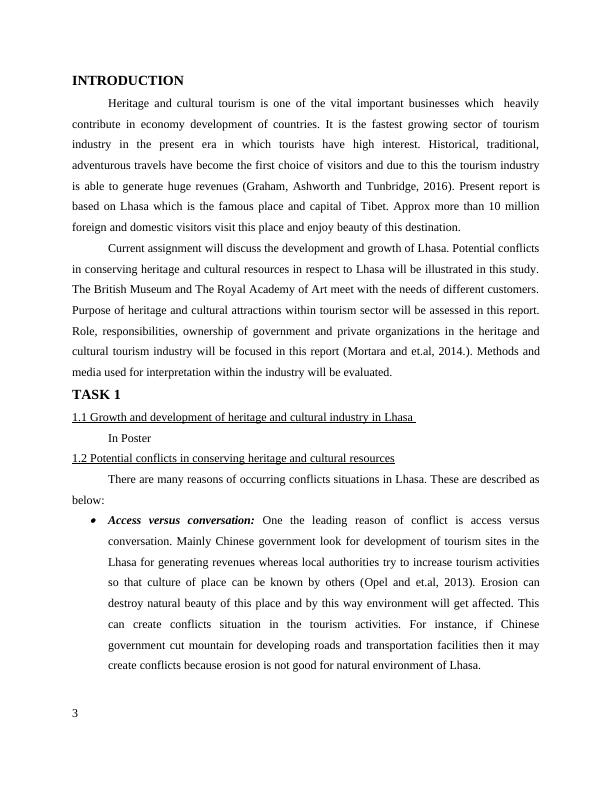Ask a question from expert
Heritage and Cultural Tourism : Lhasa
14 Pages3360 Words240 Views
Added on 2019-12-18
Heritage and Cultural Tourism : Lhasa
Added on 2019-12-18
BookmarkShareRelated Documents
HERITAGE

2

INTRODUCTIONHeritage and cultural tourism is one of the vital important businesses which heavilycontribute in economy development of countries. It is the fastest growing sector of tourismindustry in the present era in which tourists have high interest. Historical, traditional,adventurous travels have become the first choice of visitors and due to this the tourism industryis able to generate huge revenues (Graham, Ashworth and Tunbridge, 2016). Present report isbased on Lhasa which is the famous place and capital of Tibet. Approx more than 10 millionforeign and domestic visitors visit this place and enjoy beauty of this destination.Current assignment will discuss the development and growth of Lhasa. Potential conflictsin conserving heritage and cultural resources in respect to Lhasa will be illustrated in this study.The British Museum and The Royal Academy of Art meet with the needs of different customers.Purpose of heritage and cultural attractions within tourism sector will be assessed in this report.Role, responsibilities, ownership of government and private organizations in the heritage andcultural tourism industry will be focused in this report (Mortara and et.al, 2014.). Methods andmedia used for interpretation within the industry will be evaluated.TASK 11.1 Growth and development of heritage and cultural industry in Lhasa In Poster1.2 Potential conflicts in conserving heritage and cultural resourcesThere are many reasons of occurring conflicts situations in Lhasa. These are described asbelow:Access versus conversation: One the leading reason of conflict is access versusconversation. Mainly Chinese government look for development of tourism sites in theLhasa for generating revenues whereas local authorities try to increase tourism activitiesso that culture of place can be known by others (Opel and et.al, 2013). Erosion candestroy natural beauty of this place and by this way environment will get affected. Thiscan create conflicts situation in the tourism activities. For instance, if Chinesegovernment cut mountain for developing roads and transportation facilities then it maycreate conflicts because erosion is not good for natural environment of Lhasa. 3

Lack of presentation of cultural places: Lhasa is famous for the cultural dance, ritualsand traditions. But due to poor presentation in front of tourists regarding culturalbackground can create conflicts with local and host communities (Opel and et.al, 2015).Due to lack of awareness, concentration of public can be hindered and due to this Chinesegovernment will not support in protecting the natural resources. Conservation threats against growth: If planners or authorities do not focus on thedevelopment of Lhasa and they believe to keep sites outdated then it may create difficultsituation. By this way, tourism business will not grow and economic development ofTibet will be affected (Timothy, 2014).Brown field sites versus green sites: Preservation of natural places and resources is veryimportant. But development of hotels, roads, transportation, accommodation facilitiescan destruct biodiversity of Lhasa. It may turn green field sites to brown and due to these,conflicts may get arise (Barile and Saviano, 2014). Technologies and innovation: If government and local authorities do not usetechnologies well or if they use extra ordinary to these technical equipment, then it maycreate conflict situation in the place. Lack of education opportunities, poor policy makers,lack of tour operators and conservators can affect negatively on the development oftourism business in the Lhasa (Barthel-Bouchier, 2012). Apart from this, if there is lackof integrated software and equipment then authorities will not be able to generate revenueand staff will not get satisfactory training which may affect tourism business and by thisway difficulty may get arise. Capital cost and revenues generation: Referring to the case study of Lhasa Tibet, it hasbeen found that there are many mountain and landscapes. Developers like Chinesegovernment are planning to develop this place and authorities are investing huge amountin constructing hotels and roads in the location (Bloch, 2015). But local group orpopulation does not agree with this point because their source of income will getvanished by this way. Some people think that this development can create problems ofconservation thus, different views and perception can create problematic situation in theplace. 4

End of preview
Want to access all the pages? Upload your documents or become a member.
Related Documents
Discussion on potential conflicts in the conservation of heritage and cultural resourceslg...
|8
|687
|448
Report on Heritage and Cultural Tourism Management (DOC)lg...
|14
|4047
|53
Heritage and Culture Tourism Managementlg...
|17
|4667
|89
Report on Heritage and Cultural Tourism Management in United Kingdomlg...
|9
|2228
|43
Growth and Development of Heritage and Cultural Industry in Lhasalg...
|2
|761
|221
Report on Heritage and Cultural Attractionslg...
|11
|3188
|62